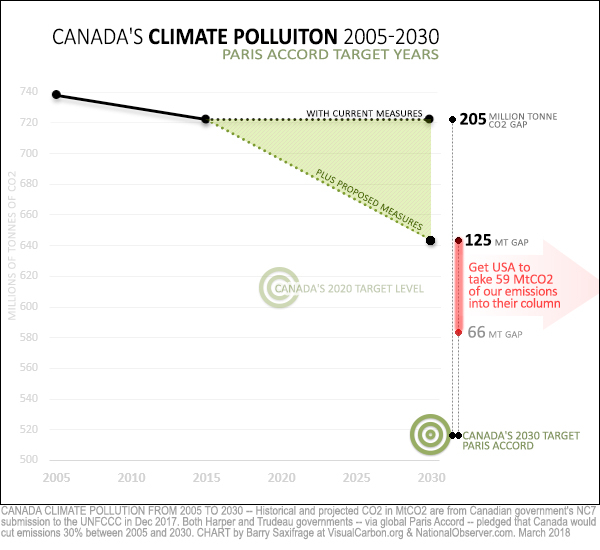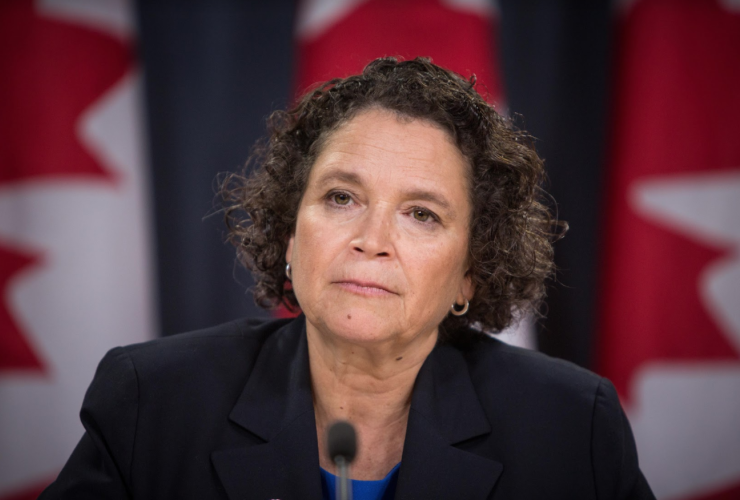Canada’s proposed climate plan doesn’t even get halfway to its goal because of problems buying offsets from the U.S.. In fact, the gap between proposed policy and Canada’s Paris commitment is twice as big as advertised.
The Trudeau government says its proposed climate policies will get Canada to within 66 million tonnes of our 2030 climate target. That's already a big gap, but the federal accounting also assumes we can subtract a huge chunk of Canada's emissions and pay to add them to the U.S. ledger through carbon credits — something the Americans haven’t agreed to do.
Canada obviously can't assign our emissions to an unwilling nation. The Paris Accord is clear on this. Without this unapproved transfer of our emissions to the United States, Canada's climate gap nearly doubles.
If the U.S. does pull out of the Paris agreement, as President Trump has vowed, then the offsets would clearly not be valid.
An tour of the climate gap, in charts
To illustrate what’s going on, here are two charts.
The first chart is by the Trudeau government showing their advertised gap of 66 million tonnes of climate pollution (66 MtCO2). It's from the executive summary of Canada's most recent official report to the United Nations, National Communication #7 (NC7).

That's already a huge gap. It’s bigger than all emissions from British Columbia, Canada’s third largest province.
The next thing to note is the blue line on the chart. It shows Canada's projected emissions under all climate policies that have actually been enacted so far: no reduction from today's level.
Finally, the green wedge shows the additional reductions expected if the rest of Canada's proposed clean growth and climate plan gets enacted. This wedge also includes the accounting which unilaterally transfers a large chunk of our emissions to the United States' account.
How big a chunk? Tucked away on page 153 of the NC7 report is the answer: 59 MtCO2.
For scale, this equals the total combined climate pollution from all four Atlantic provinces, plus Manitoba.
The government doesn't break this out on their charts, so I created the chart below to let you see how it fits in.

On this second chart, the green wedge only shows the projected reductions inside Canada from proposed policies.
Then, in red, I break out the 59 MtCO2 of emissions the Trudeau government is assigning to the United States.
Because the American administration hasn’t agreed to this, Canada's policies are currently 125 MtCO2 short of what is needed. Double the advertised gap.
As the chart also shows, even if all of the Trudeau government’s clean growth and climate policies get enacted, Canada's emissions will only shrink to 640 MtCO2 per year by 2030. That's as low as our country’s actual climate pollution is projected to fall. To appreciate how high this is, consider it is:
- less than half way to our 2030 Paris Accord target.
- still well above our 2020 Copenhagen Accord target… in 2030.
How did we get here? And what are some possible solutions?
Understanding Canada's 'USA offsets' problem
Years ago, lacking federal leadership in either country, a number of U.S. states formed a cap-and-trade group called the Western Climate Initiative (WCI) and four Canadian provinces joined in.
It turns out that reducing climate pollution in California is generally much less expensive than in Ontario or Quebec. For one thing California's economy is huge, exceeding all of Canada’s. So, there are many more opportunities to cut emissions.
Because of this price difference, Ontario and Quebec are net purchasers of "emission offsets" from California. They pay California to cut emissions and in return California lets them count the emissions reductions on their provincial books.
In theory, Ontario and Quebec benefit by paying less than cutting emissions at home. The downside is that they are sending money out their economies, and the provinces are making the low-carbon transition more slowly.
The opposite is true for California. The Golden State gets money flowing into their economy to pay for a faster low-carbon transition. The downside is that they must claim more climate pollution than they really emit.
By 2030, the Trudeau government projects that Ontario and Quebec will be buying 59 MtCO2 worth from WCI offsets from California.
These are the offsets the Trudeau government are including in their national accounting: "allowances purchased internationally under the Western Climate Initiative (WCI) cap-and-trade program…have been included in the additional measures" — NC7 page 150.
The problem for Canada is that the United States federal government has never been a party to the WCI. And the United States has never agreed to honour California's roll-your-own offsets at the national level.
As a result, Canada finds itself in a situation where Ontario and Quebec are planning to meet 59 MtCO2 of their provincial reductions in a way that does not count towards the nation's climate target.
It's obvious why the Trudeau government wants WCI offsets to count at the national level. But it's not something Canada can just unilaterally decide to do. The United States must agree. The Paris Accord clearly forbids "double counting" of emissions reductions.
At this point, it appears that 59 MtCO2 of Canadian emissions have just disappeared from global accounting. Canada isn't taking responsibility for them, and we haven't found anyone else to take them for us.
Possible alternatives
One possible solution is for Ontario and Quebec to stop buying WCI offsets and to reduce emissions inside Canada instead.
Wouldn't this be a lot more expensive?
To estimate the cost to meet Canada's Paris Accord target -- with and without WCI offsets -- Dave Sawyer (EnviroEconomics) and Dr. Chris Bataille (SFU) ran the numbers.
If Canada could count California's WCI offsets, the effective carbon price needed to meet our target would be around $150 per tonne of CO2 by 2030.
Not having access to WCI offsets raises that to $220 per tonne. But Sawyer and Bataille also found that if Canada allows large industrial emitters to trade offsets across provincial borders then emissions reductions would come as cheaply domestically as with international WCI offsets.
You could think of this as creating "pan-Canadian offsets." In this scenario, an Ontario company could pay an Alberta company to cut emissions, rather than paying a California company to do it under the WCI.
In an email, Dr Bataille said Ontario and Quebec would be "economically better off in a federal Canadian trading system with Alberta." He estimates the carbon price to meet Canada's 2030 Paris Accord climate target could be even lower than with WCI: perhaps around $125 to $130 per tonne.
Additional benefits from this pan-Canadian offset trading system would be:
- Canadian dollars spent on offsets stay in the country
- More low-carbon transition takes place in Canada's economy
- Offsets are legal under global accounting rules for Canada's Paris Accord targets
- Canada maintains control. We aren't relying on other nations acting the way we need.
So far, the Trudeau government hasn’t offered up any plans to close the 66 Mt gap it acknowledges, much less any plans to deal with a gap twice that size. It has policy options available but not a lot of time to deliver. In just a year and a half it will face its own accounting in the next federal election.
—
Editor's note: Environment and Climate Change Canada was asked to comment on whether the U.S. has agreed, even in principle, to honour WCI offsets in their accounting. Here is their response:
"Parties to the Paris Agreement are currently negotiating the guidance on accounting for Nationally Determined Contributions, including with respect to the use of Internationally Transferred Mitigation Outcomes (ITMOs) under Article 6 of the Agreement. The Government of Canada continues to work with Ontario, Quebec, and other interested provinces and territories, as well as with international partners, to ensure that allowances acquired through international emissions trading are counted towards Canada’s international target. With respect to the United States position on these matters, we recommend directing your inquiry to the U.S. State Department."
Dear Mr. Saxifrage:
Dear Mr. Saxifrage:
Thank you for this information. This seems a complex issue, given the benefits of the international cap-and-trade agreement. Could you clarify more precisely in what way the US-based offsets are not allowed under the Paris Accord? You are clear that countries cannot "double-dip"; are you implying that the US might be expected to include these offset Canadian emission reductions in their accounting? If so, is there evidence for this expectation? If the US pulls out of the Paris Accord, might their accounting not become legally moot, and so allow us to legitimately count these particular reductions?
Excellent sleuthing, analysis
Excellent sleuthing, analysis and reporting. This is important as it keeps the discussion going and keeps the deciders' feet to the fire.





Comments